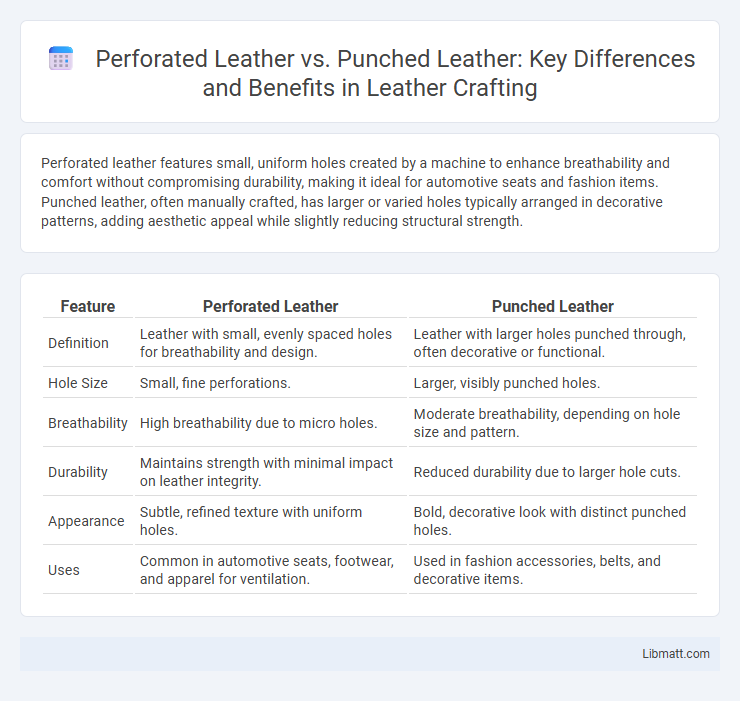Perforated leather features small, uniform holes created by a machine to enhance breathability and comfort without compromising durability, making it ideal for automotive seats and fashion items. Punched leather, often manually crafted, has larger or varied holes typically arranged in decorative patterns, adding aesthetic appeal while slightly reducing structural strength.
Table of Comparison
| Feature | Perforated Leather | Punched Leather |
|---|---|---|
| Definition | Leather with small, evenly spaced holes for breathability and design. | Leather with larger holes punched through, often decorative or functional. |
| Hole Size | Small, fine perforations. | Larger, visibly punched holes. |
| Breathability | High breathability due to micro holes. | Moderate breathability, depending on hole size and pattern. |
| Durability | Maintains strength with minimal impact on leather integrity. | Reduced durability due to larger hole cuts. |
| Appearance | Subtle, refined texture with uniform holes. | Bold, decorative look with distinct punched holes. |
| Uses | Common in automotive seats, footwear, and apparel for ventilation. | Used in fashion accessories, belts, and decorative items. |
Introduction to Perforated vs Punched Leather
Perforated leather features evenly spaced holes created by precise machinery, enhancing breathability and comfort in various applications such as automotive seats and fashion. Punched leather, on the other hand, involves larger, manually or mechanically created holes with decorative or functional purposes, often seen in traditional leatherwork and crafts. To choose the best option for your project, consider the intended ventilation needs, aesthetic preferences, and durability requirements of each type.
What Is Perforated Leather?
Perforated leather features small, precisely punched holes that enhance breathability and reduce weight, commonly used in automotive seats and athletic footwear. The perforations improve air circulation, helping to keep the surface cooler and more comfortable during extended use. This type of leather combines durability with functional ventilation, distinguishing it from punched leather, which may have larger or less uniform holes primarily for decorative purposes.
Defining Punched Leather
Punched leather refers to hides that have been mechanically perforated with a series of small holes or patterns, enhancing breathability and flexibility without compromising durability. This technique differs from traditional perforated leather primarily in the precision and uniformity of hole placement, often achieved through advanced punching machines for consistent results. Punched leather is widely used in automotive upholstery, footwear, and fashion accessories to improve ventilation while maintaining aesthetic appeal.
Manufacturing Processes Compared
Perforated leather is produced through a precise mechanical process that uses a punch press or laser to create uniform holes, enhancing breathability and aesthetic appeal. Punched leather involves manually or mechanically removing sections of material to create larger, often irregular holes, typically for decorative or ventilation purposes. The key manufacturing difference lies in the method's precision and hole size, with perforated leather featuring consistent, smaller perforations and punched leather showcasing larger, less uniform openings.
Differences in Appearance and Texture
Perforated leather features evenly spaced, small holes that create a uniform pattern, enhancing breathability and offering a smooth texture with subtle ventilation. Punched leather displays larger, sometimes irregular holes that can vary in shape and spacing, resulting in a more rugged appearance and a coarser, tactile feel. Understanding these differences helps you choose between the sleek, refined look of perforated leather and the distinctive, bold character of punched leather for your specific design needs.
Breathability and Comfort
Perforated leather features small, evenly spaced holes that enhance breathability by allowing air circulation, reducing heat and moisture buildup on the skin. Punched leather, created by larger, less uniform holes, offers moderate ventilation but may compromise structural integrity and comfort over extended wear. The precise perforation pattern in perforated leather ensures superior comfort by maintaining flexibility and minimizing irritation.
Durability and Longevity
Perforated leather features small, precision-cut holes that maintain structural integrity, offering slightly better durability and longevity compared to punched leather, which is created by manually punching larger holes that may weaken the material over time. Your choice between perforated and punched leather can impact how well the material withstands daily wear and environmental stressors, with perforated leather generally providing enhanced breathability without compromising strength. For products requiring long-lasting performance, perforated leather is often the preferred option due to its consistent craftsmanship and resistance to tearing.
Common Uses in Fashion and Automotive
Perforated leather, characterized by uniform, small holes, is commonly used in automotive interiors to enhance breathability and comfort, especially in car seats and steering wheels. Punched leather features larger, often decorative holes and finds frequent application in fashion accessories like belts, handbags, and shoes for aesthetic appeal and ventilation. Your choice between perforated and punched leather should depend on the balance you seek between functional breathability and stylistic expression in either automotive or fashion design.
Maintenance and Cleaning Tips
Perforated leather requires gentle cleaning with a soft brush or vacuum to remove dirt from small holes without damaging the material, followed by wiping with a damp cloth and leather conditioner to maintain flexibility. Punched leather, having larger, distinct holes, allows easier debris removal but still benefits from regular dusting and conditioning to prevent drying and cracking. Both types avoid harsh chemicals or excessive moisture to preserve the integrity and appearance of the leather over time.
Choosing the Right Leather for Your Needs
Perforated leather features tiny, laser-cut holes that improve breathability and are ideal for car seats and fashion items requiring ventilation. Punched leather, created using hand tools or machines to produce larger holes, offers more decorative, bold patterns suitable for handbags and accessories. Your choice depends on whether you prioritize ventilation and comfort or distinctive, eye-catching design.
Perforated leather vs punched leather Infographic

 libmatt.com
libmatt.com